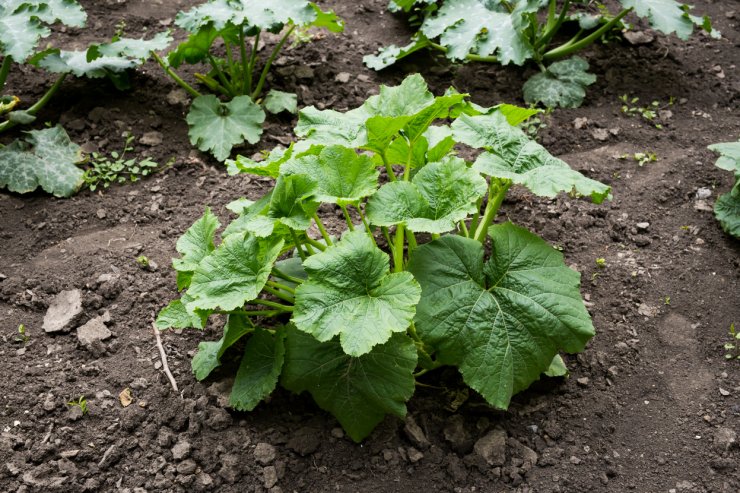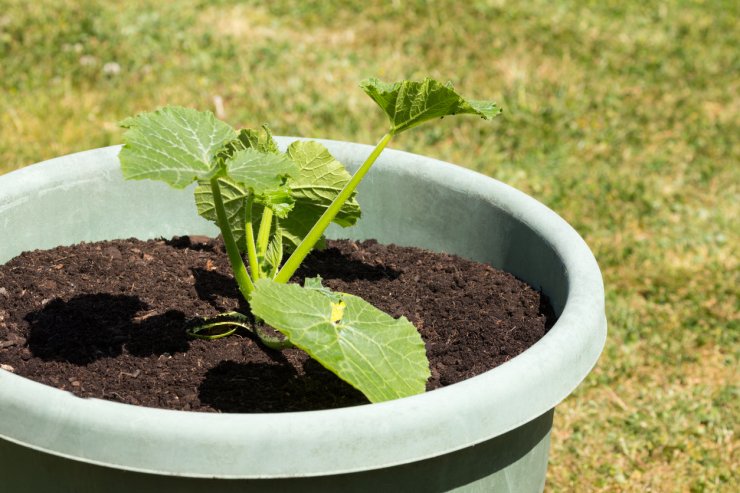
Zucchini growing in open land.
When first planning your squash garden, you should consider the type of land you can tend. If you have a large outside plot of land with the right soil and the right conditions for watering and draining, you might have the ideal situation for planting directly in the ground.
If, however, your soil is too sandy or not the right composition, you might want to consider planting in raised beds or in containers or pots. Converting your open-land plot into a usable garden might involve a lot of time and effort better spent considering raised beds or containers.
Growing in Raised Beds
![Zucchini plant in raised bed]](/wp-content/uploads/2020/12/iStock-483263290-e1608234239515-740x494.jpg)
Zucchini plant in raised bed]
Creating raised beds for your garden can be a lot of work the first time you set up your beds, but having raised beds allows you more control over your growing environment. You’ll discover that watering, irrigation, weeding, and even harvesting are much easier, with items closer to your reach and contained in a space that is more manageable than growing in open land. And once you create your raised beds the first time, subsequent years will be easier.
To create nicely contained raised beds for your plants, enclose your raised beds with wooden sides at least 8 inches wide—this will help keep the bed together, be tall enough, and make irrigation easier, too.
With raised beds, your garden is less likely to contain the seeds of weeds that are often found in garden soil. You’ll minimize the incidence of weeds overall, which will save you time and effort later. Weeding itself is much easier with raised beds, because you don’t have to get down so far on the ground to remove weeds.
- Annual Tip: To optimize the soil in your raised beds, be sure to amend your soil with composting at least once a year—otherwise, your soil can become less productive for your plants.
Growing Squash in Containers or Pots

Growing squash in a container.
Not everyone has the land space for outdoor gardens, but that’s not a problem with squash! Like many other plants, it will happily grow in a container on your patio, terrace, deck, or balcony with the right care. Just remember that plants grown in pots require more frequent watering than plants in the ground, so be aware of periods of extreme heat.
Your soil may also become depleted, so remember to fertilize your plant throughout the summer.
And contrary to what you might think, plants like squash will produce just as much fruit in a pot as they do in the ground, as long as you pick a suitable variety to grow—a variety that’s not too big or bushy, and that doesn’t need more space for vining—and care for it adequately.
You might even consider adding a trellis to your pot, to get the squash to grow vertically. Whether in pots or in the ground, trellis growing allows greater circulation of sunlight and air, which in turn discourage pests and diseases. Just remember you’ll need a sling of some kind to support the fruit as it grows, so its weight doesn’t pull it from the plant too soon.
One great advantage to container gardening is the ability to move plants around more easily to maximize their exposure to the sun.
- Tip: If you have trouble moving pots around, because they’re too heavy or too bulky, try putting your pots on rolling casters so you can more easily move them around your space.
What to do with your container soil at the end of the season: At the end of your squash-growing season, the soil in your pots will be spent, which means starting over when you create next year’s garden. Dispose of the soil at the end of the season by dumping the soil somewhere else—in another part of your yard or a place where you won’t be growing plants again.
How do you grow your squash—in open land, in raised beds, or in containers? Why do you prefer your method? Please tell us your tips and tricks for creating an awesome garden no matter where you live.


 Previous
Previous


Doris,
Thank you so much for sharing your experience with recycling and reusing container soil and how you successfully achieve the right green/brown balance with composting. We love input from our friends in the gardening community!
I’ve shared your comment with Amanda (our Senior Editor at FGN) because I think there are lots of gardeners who often wonder if they should or could reuse potting soil and what it would take to rehabilitate and refresh it. This topic will make a great article for our Daily Newsletter.
I find discarding spent container soil very impractical. Here in the north, with a growing season of about 80 frost free days, and primarily clay as the soil in my yard, I try to rehabilitate all of that. Since potting soils in hanging baskets ( which my neighbours who do not garden enjoy) contain perlite which is expensive and useful in providing aeration in the soil, I take their baskets, chop and compost the tops, and put the rest into garbage cans for the winter. Frost takes care of much of the roots left, and then I can sift and add it to new soil for my raised beds and pots. I used to have a lot of deciduous trees (cottonwoods, which eventually invaded my foundation) which provided lots of leaves for compost, which was good because I have a lot of grass to cut. A couple of them were rotting in the centre, and the roots in the basement were causing water to get in, so I got rid of them, all 13. The dried leaves balanced out the grass, but now I have needed to be a little more resourceful, so if the soil in the pots does not break up easily, it goes into the compost pile to give it a better balance to work. Finished compost goes into garbage cans and rests for a year before use.